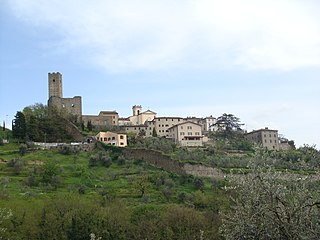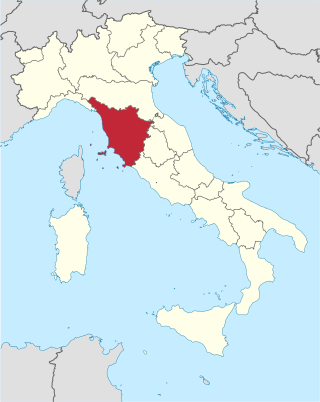
Empoli is a town and comune in the Metropolitan City of Florence, Tuscany, Italy, about 30 km southwest of Florence, to the south of the Arno in a plain formed by the river. The plain has been usable for agriculture since Roman times. The commune's territory becomes hilly as it departs from the river. Empoli is on the main railway line from Florence to Pisa, and is the point of divergence of a line to Siena. Empoli has an enduring tradition as an agricultural centre. It has given its name to a local variety of artichoke.

The Battle of Campaldino was a battle between the Guelphs and Ghibellines on 11 June 1289. Mixed bands of pro-papal Guelf forces of Florence and allies, Pistoia, Lucca, Siena, and Prato, all loosely commanded by the paid condottiero Amerigo di Narbona with his own professional following, met a Ghibelline force from Arezzo including the perhaps reluctant bishop, Guglielmino degli Ubertini, in the plain of Campaldino, which leads from Pratovecchio to Poppi, part of the Tuscan countryside along the upper Arno called the Casentino. One of the combatants on the Guelph side was Dante Alighieri, twenty-four years old at the time.

The House of Malatesta was an Italian family that ruled over Rimini from 1295 until 1500, as well as other lands and towns in Romagna and holding high positions in the government of cities in present day Tuscany, Lombardy and Marche. The dynasty is considered among the most important and influential of the Late Middle Ages. In the period of maximum influence, they extended their domains along the Marche coast, up to Ascoli Piceno, Senigallia, Sansepolcro and Citerna, and to the north, on the territories of Bergamo and Brescia.

The Republic of Lucca was a medieval and early modern state that was centered on the Italian city of Lucca in Tuscany, which lasted from 1160 to 1805.

Tommaso Baldasarre Crudeli was a Florentine free thinker who was imprisoned by the Roman Inquisition. He was a poet, lawyer, champion of free thought and is remembered as the first martyr of Universal Freemasonry.

Boniface III, son of Tedald of Canossa and the father of Matilda of Tuscany, was the most powerful north Italian prince of his age. By inheritance he was count of Brescia, Canossa, Ferrara, Florence, Lucca, Mantua, Modena, Pisa, Pistoia, Parma, Reggio, and Verona from 1007 and, by appointment, margrave of Tuscany from 1027 until his assassination in 1052.

Montevarchi is a town and comune in the province of Arezzo, Tuscany, Italy.

Larciano is a comune (municipality) in the Province of Pistoia in the Italian region of Tuscany. The town hall is located in San Rocco.

Poppi is a comune (municipality) in the Province of Arezzo in the Italian region Tuscany, located about 40 km east of Florence and about 30 km northwest of Arezzo.

Stia is a frazione of the comune of Pratovecchio Stia in the Province of Arezzo in the Italian region Tuscany, located about 40 kilometres (25 mi) east of Florence and about 40 kilometres (25 mi) northwest of Arezzo. It was an independent commune until it was merged to Pratovecchio in 2014.

The Simonetti family is an Italian noble family with origins in Tuscany. During the 12th Century different branches in Florence, Terni, Lucca, Pistoia and Pescia developed. Other famous branches of this family were established in Jesi, Palermo, Milan and Bologna.
Gualdrada Berti dei Ravignani was a member of the Ghibelline nobility of twelfth-century Florence, Italy. A descendant of the Ravignani family and daughter of the powerful Bellincione Berti, Gualdrada later married into the Conti Guido family. Her character as a pure and virtuous Florentine woman is called upon by many late medieval Italian authors, including Dante Alighieri, Giovanni Boccaccio, and Giovanni Villani.

Tuscany is a region in central Italy with an area of about 23,000 square kilometres and a population of about 3.8 million inhabitants. The regional capital is Florence (Firenze).

Poppi Castle is a medieval castle in Poppi, Tuscany, Italy, formerly the property of the noble Guidi family.

The Valdarno is a breed of black dual-purpose chicken from the lower part of the Valdarno, the valley of the Arno river, in Tuscany, central Italy. It became virtually extinct in the 20th century, but the population is recovering. It is a quite different breed from the Valdarnese, which originates in the upper Valdarno, and is white.

The House of Guidi di Bagno is an old Italian noble family which moved first into Romagna and then into Mantua from the 14th century.
Conrad was the margrave of Tuscany from 1119/20 until 1129/31. He was a German, appointed by the Emperor Henry V to bring Tuscany back under imperial control. During the long Investiture Controversy, the Tuscan countess Matilda of Canossa had taken the ecclesiastical side against the emperor and imperial influence in the Tuscan margraviate was at low ebb upon her death in 1115. Conrad was the second in a series of 12th-century German appointees who proved too weak to restore imperial control and whose tenures are associated with the rise of self-government in the Tuscan cities—Florence, Genoa, Lucca, Pisa and Siena.
The following is a timeline of the history of the city of Pistoia in the Tuscany region of Italy.

Guido Guerra V (1220-1272) was a politician from Florence, Italy. Aligned with the Guelph faction, Guerra had a prominent role in the political conflicts of mid-thirteenth century Tuscany. He was admired by Dante Alighieri, who granted him honor in the Divine Comedy, even though he placed Guerra in Hell among sinners of sodomy.

















